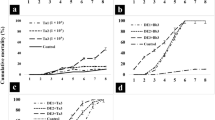Abstract
Diamondback moth, Plutella xylostella, is one of the most destructive insect pests of several crops world-wide. Effects of Paenibacillus elgii HOA73 and its combined application with organic sulfur pesticide on Plutella xylostella were evaluated. Results showed that M3 medium composition indicated the best medium for optimization of bacterial colony growth, hydrolytic enzyme production, and insecticidal activity and was selected for culturing P. elgii HOA73 in further assays. The highest colony growth of P. elgii HOA73 was identified at 5 days after inoculation. Extracted crude enzyme and crude insecticidal compound from P. elgii HOA73 cultured in the optimized medium kill the second instar larvae of Diamondback moth in 40 and 50% at 220mg mL−1 of crude enzyme and 2% crude extract, respectively. Combined application of organic sulfur pesticide with bacterial suspension significantly killed 85% second instar larvae of Diamondback moth, when compared to use of single application: bacterial suspension (65%) and organic sulfur pesticide (38%), suggesting that P. elgii HOA73 combined with organic sulfur pesticide could be used to control P. xylostella.
Similar content being viewed by others
References
Akolkar A, Bharambe N, Trivedi S, and Desai A (2009) Statistical optimization of medium components for extracellular protease production by an extreme haloarchaeon, Halobacterium sp. SP1(1). Lett Appl Microbiol 48, 77–83.
Chagas PRR, Tokeshi H, and Alves MC (2001) Efficiency of lime sulfur in the control of the two-spotted mite in papaya in conventional and organic (Bokashi- EM) systems. In Sixth International Conference on Kyusei Nature Farming. Proceedings of the conference on greater productivity and a cleaner environment through Kyusei Nature Farming, University of Pretoria, Pretoria, South Africa. International Nature Farming Research Center (INFRC), Japan.
Choi SK, Park SY, Kim R, Lee CH, Kim JF, and Park SH (2008) Identification and functional analysis of the fusaridin biosynthetic gene of Paenibacillus polymyxa E681. Biochem Biophys Res Commun 365, 89–95.
Das SN, Dutta S, Kondreddy A, Chilukoti N, Sarma VS, Pullabhotla RN et al. (2010) Plant Growth-Promoting Chitinolytic Paenibacillus elgii Responds Positively to Tobacco Root Exudates. J Plant Growth Regul 29, 409–418.
Derek WG, Thomas BM, and Micheal AO (2001) In A toxicological assessment of sulfur as a pesticide, Robert K, John D, Donald E, Derek G, Ernest H, Larry R et al. (eds.), Handbook of Pesticide Toxicology, 1781–1791, Academic Press, USA.
Furlong MJ, Wright DJ, and Dosdall LM (2013) Diamondback Moth Ecology and Management: Problems, Progress, and Prospects. Annu Rev Entomol 58, 517–541.
Hepburn HR (1985) Structure of the Integument. In Comprehensive Insect Physiology, Biochemistry and Pharmacology, Kerkut GA and Gilbert LI (3rd ed.), pp. 1–58, Pergamon Press, USA.
Heulin T, Berg O, Mavingui P, Gouzuo L, Hebbar KP, and Baladreau J (1994) Bacillus polymyxa and Rahnella aquatilis, the dominant N2 -fixing bacteria associated with wheat rhizosphere in French soils. Eur J Soil Biol 30, 35–42.
Jang JY, Yang SY, Kim YC, Lee CW, Park MS, Kim JC et al. (2013) Identification of orfamide A as an insecticidal metabolite produced by Pseudomonas protegens F6. J Agric Food Chem 61, 6786–6791.
Kembhavi AA, Kulkarni A, and Pant A (1993) Salt-tolerant and thermostable alkalien protease from Bacillus subtilis NCIM No. 64. Appl Biochem Biotechnol 38, 83–92.
Kim DS, Bae CY, Jeon JJ, Chun SJ, Oh HW, Hong SG et al. (2004) Paenibacillus elgii sp. nov., with broad antimicrobial activity. Inter J System Evol Microbio 54, 2031–2035.
Mnif I, Elleuch M, Chaabouni SE, and Ghribi D (2012) Bacillus subtilis SPB1 biosurfactant: production optimization and insecticidal activity against the carob moth Ectomyelois ceratoniae. Crop Protec 50, 66–72.
Nielsen P and Sorensen J (1997) Multi-target and medium-independent fungal antagonism by hydrolytic enzymes in Paenibacillus polymyxa and Bacillus pumilus strains from barley rhizoshpere. FEMS Microbiol Ecol 22, 183–192
Nugroho BW, Schwarz B, Wray V, and Proksch P (1996) Insecticidal constituents from rhizomes of Zingiber cassumunar and Kaempferia rotunda. Phytochem 41, 129–132.
Raza W, Hongsheng W, and Qirong S (2010) Use of response surface methodology to evaluate the effect of metal ions (Ca2+, Ni2+, Mn2+, Cu2+) on production of antifungal compounds by Paenibacillus polymyxa. Bioresour Technol 101, 1904–1912.
RDA (2008) Development of IPM Technology for Environment-friendly Managed Citrus Orchards. Site Joint Cooperating Agricultural Researchpromoting Project, Rural Development Administration, Korea.
Singh HP and Singh TA (1993) The interaction of rockphosphate, Bradyrhizobium, vesicular-arbuscular mycorrhizae and phosphate solubilizing microbes on soybean grown in a sub-Himalayan mollisol. Mycorri 4, 37–43.
Talekar NS and Shelton AM (1993) Biology, ecology, and management of the diamondback moth. Annu Rev Entomol 38, 275–301.
Wu XC, Shen XB, Ding R, Qian CD, Fang HH, and Li O (2010) Isolation and partial characterization of antibiotics produced by Paenibacillus elgii B69. FEMS Microbiol Lett 310, 32–38.
Zalucki MP, Shabbir A, Silva R, Adamson D, Shu-Sheng L, and Furlong MJ (2012) Estimating the economic cost of one of the world’s major insect pests, Plutella xylostella: Just how long is a piece of string? J Econ Entomol 105, 1115–1129.
Author information
Authors and Affiliations
Corresponding author
Rights and permissions
About this article
Cite this article
Neung, S., Nguyen, X.H., Naing, K.W. et al. Insecticidal potential of Paenibacillus elgii HOA73 and its combination with organic sulfur pesticide on diamondback moth, Plutella xylostella . J Korean Soc Appl Biol Chem 57, 181–186 (2014). https://doi.org/10.1007/s13765-013-4273-4
Received:
Accepted:
Published:
Issue Date:
DOI: https://doi.org/10.1007/s13765-013-4273-4




